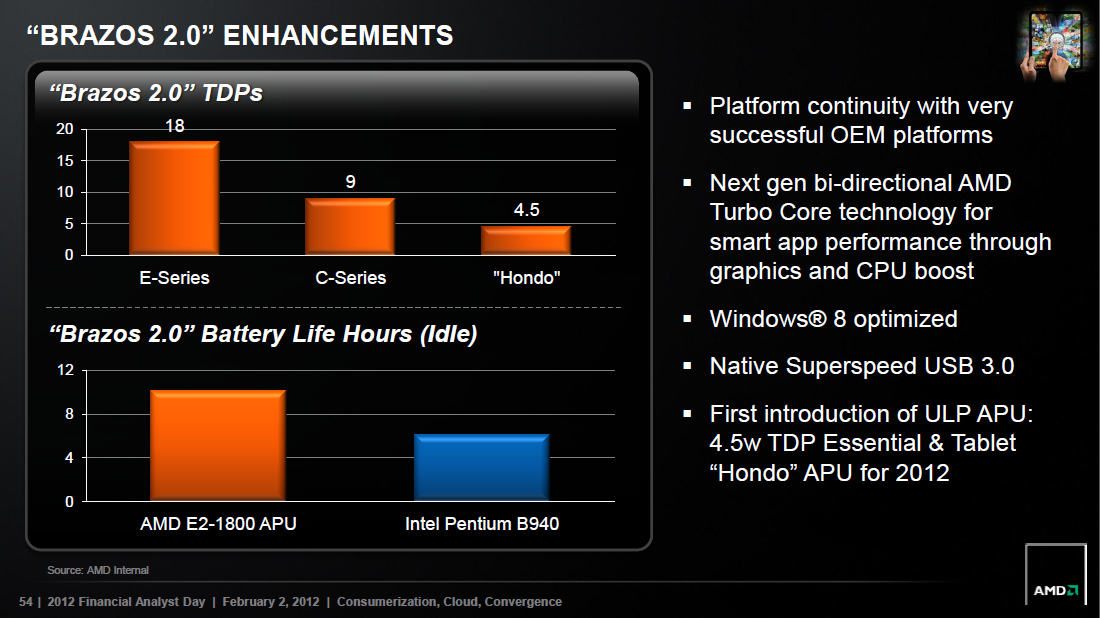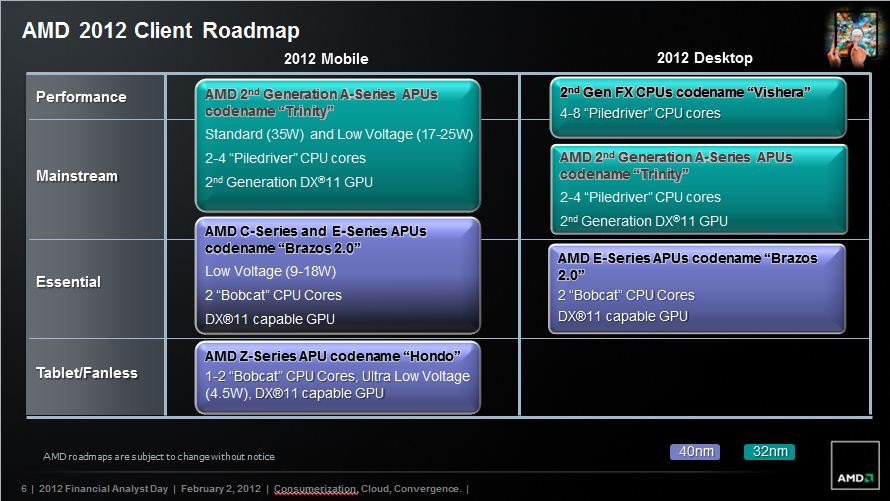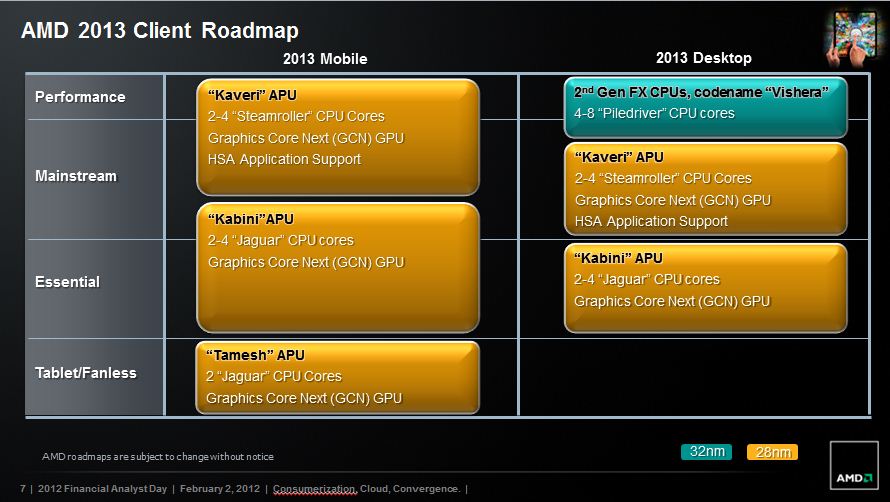After a long wait AMD has finalled arranged the annual Analyst Day that was postponed from November to early 2012. Besides a completely changed business focus, and has released new roadmaps for the coming year.
AMD has managed to keep the lid on and earlier this week was the first time it openly discussed what was going on inside the company. The roadmaps looks as expected, with a couple of new details. Also the first signs that AMD will remove itself from the enthusiast market, when you read between the lines, during Analyst Day, and the company will try to reach a much broader market than before.
First we have Brazos 2.0, and it sounds just as interesting as it is. It is the same archtiecture as before. Brazos 2.0 will sport a more advanced Turbo Core technology than before, and integrated support for USB 3.0. That it is much like the older platform will make it easier to get it out on the market much faster, than when doing a whole new platform.
Krishna and Wichita was supposed to have replaced Brazos, but was trashed. The reason was that it would have been more expensive to make at 28nm and that the demand for 28nm is high for other products, which means the capacity may not be sufficient. Brazos is AMD’s most successful platform ever with over 30 million sold units last year. Rory Read pushed for Brazos being fast, simple and cheap to make. When Brazos launched availability was poor, which hurt its relation with the manufacturers, a mistake it will not make again. We would not mind a replacement for Brazos, but at the same time we wonder if it is really needed considering what Intel has to offer with Atom?
Hondo will be a new addition, although based on Brazos. It is an optimized platform with the same specification as a C-50, with two Bobcat cores clocked at 1 GHz and 80 Radeon cores at 280 MHz. The difference is that it has reduced the energy consumption to 4.5W, and paired it with a more efficient and less functional southbridge. Hondo will target tablets, but also notebook makers.
Trinity will offer 2 – 4 Piledriver cores and a graphics circuit with DirectX 11 support. This circuit will be based on the VLIW4 architecture we find in Cayman, with the latest video technologies found in the GCN architecture used by the HD 7000 series. On the mobile side it has made great progress with Trinity over Llano seen to energy efficiency. AMD will therefore offer 35W models in the ordinary lineup, and then 17 – 25W models for the ultrathin market. Trinity will most likely arrived toward the end of Q2 and is already with AMD partners.
Vishera will replace Komodo. Komodo would have sported 10 cores, integrated PCI Express and triple-channel memory. AMD says that it isntead decided to use the exact same socket and infrastructure as before, and the result was Vishera. The Piledriver cores also found in Trinity will bring performance optimizations, as well as higher clock frequencies than Bulldozer. Hopefully the 8 cores in Vishera can be clocked higher than the 10 cores in Komodo would have. This means that it will use the same infrastructure as before, which is socket AM3+. Vishera should arrive during the Fall/October, about a year after Bulldozer and the FX series.
In 2013 there will be plenty of news, and all builds on 28nm – almost. Vishera will stay at 32nm in the enthusiast and performance segment, and no changes to be seen at the moment.
Kabini replaces Brazos 2.0, and sports 2 – 4 Jaguar cores. Jaguar is the next generation Bobcat, with both performance and power optimizations. Kabini sports AMD’s GCN architecture in the graphics circuits. That Brazos is not upgraded until 2013, is because the platform needs to be available in large quantites to cover partner demand (read above).
Tamesh is a new name to us, and replaces Hondo. Tamesh will sport two Jaguar cores, and AMD’s GCN architecture. The only thing we know is that Tamesh will be even more efficient, and that AMD recruit Lisa Su said that AMD is capable of scaling x86 below 2W. If this applies to this platform or if there is something even better coming in the future we will leave to you to speculate. Both Kabini and Temash will be the first circuits to have the southbridge inside the processor on the same silicon, to create a complete SoC (System On a Chip).
Kaveri will replace Trinity and be built at 28nm. Most likely it will be GlobalFoundrie’s 28nm HPP (High Performance Plus) technology, which is an extension of the current 32nm technology that is used today. Kaveri sports 2 – 4 Steamroller cores, that in turn is an improved version of the Piledriver cores used in Trinity and Vishera. It will also sport the GCN architecture, but most likely in the next generation: Sea Islands. The new about Sea Islands is that the processor and the graphics circuit will be able to share memory, and thus work more efficiently together.
The enthusiast market, where did you go?
One thing was made obvious, AMD will be focusing on the future retail market and applications that are up and coming. The bullet points are Cloud, Consumerization and Convergence. Having a cloud and ecosystem that ties all products together is requested more and more among consumers, and more product segments are being woven together.

When discussing AMD and Intel, the latter has dominated the enthusiast market, high-end performance segments and overclocking overall. It was made clear that AMD has completely other plans for the future. We can see that Vishera will be around for quite some time and will have to battle Intel Haswell in 2013. It intends to focus on the Fusion concept, and get more software out to support its APUs. Is it a possible replacement for the traditional processor?


















